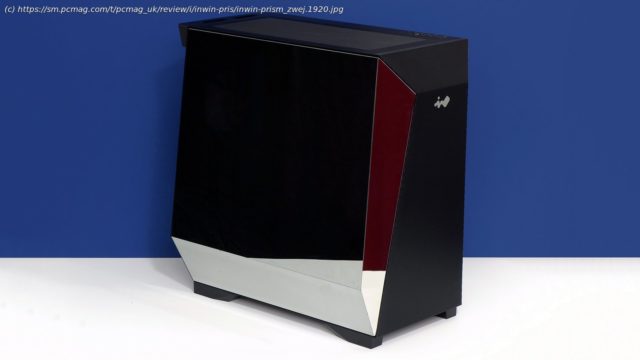The InWin Prism’s striking mirrored panels and wealth of RGB lighting will inspire expert DIY-ers to elevate this elegant case’s cooling performance in their next vanity PC build.
InWin’s efforts in the mainstream PC case market endear the company to cost-conscious builders who have an eye for style. Its design team has spent two decades distancing itself from the firm’s early days of selling beige boxes to system integrators. Along the way, it has developed a clear aesthetic of its own, even venturing into so-called “Signature” limited-edition cases that are like nothing else on the market.
Take today’s sample, the Prism ($220). It’s derived from a classic, mirror-sided flagship case called the Tòu. The Prism takes the stunning appearance of the around-$800, long-deleted Tòu and adds a bunch of the firm’s classic practicality at a much lower price. You’ll buy it because you like how it looks; once you do, you’ll figure out how to get it to perform at its best. We’d offer up a better-performing alternative for its size and price, and there are a bunch, but the aesthetic here is unique. The mirror finish is really what this case is all about, and why you’d buy it, or not. We find it charming.Design: A Case That’s Through the Looking Glass
InWin introduced similar wedge shapes and mirrored panels in the mostly glass Tòu over a decade ago, but that creation used custom-cut plates and castings to hold those panels together. The Prism simplifies all that by building off a standard rectangular box. To reduce cost, only the leftward-facing panels are mirrors, and InWin completely ditched the 2014 version’s nifty touch-sensitive controls. The literal and figurative corners cut bring the Prism’s price down to an almost-acceptable $219.99.
The key ports (two USB 3.x Type-A, and one Type-C) are at the front right edge of the top panel, between a light-up power button, a headphone/mic combo jack, and a mode button for the Prism’s integrated ARGB controller. The power button’s LED indicates that the system is powered on, with most of its center section blacked out to leave just a lit ring around its edge and a pinpoint at its center. It looks sporty.
Triangular panels fill the gaps between the Prism’s trapezoidal sides and its rectangular back, the latter featuring a removable/rotatable seven-slot panel for PCI Express cards. Four long slots maximize the vertical-adjustment range for the included 120mm ARGB exhaust fan. Also visible below: The right side’s panel features a vented section that serves a side-facing internal radiator mount.
A long dust filter that’s accessible from the front of the case covers nearly the entire bottom of the case, screening all of its intake vents, including the power supply’s air inlet.
The side vent, too, is covered by a dust filter, but this one is simply stuck in place using adhesive-backed magnetic strips. The hook seen protruding from the panel’s bottom edge is one of two that secure it to the case. The top edge is secured using ball-and-socket snaps.
InWin fills the Prism’s side radiator mount with three of its VX120 Vortex ARGB fans, again in exhaust orientation. The steel sheet that makes up the fan bracket steps almost an inch-and-a-half toward the center of the case before becoming the motherboard tray, the stepped section featuring several cable-passage holes.






